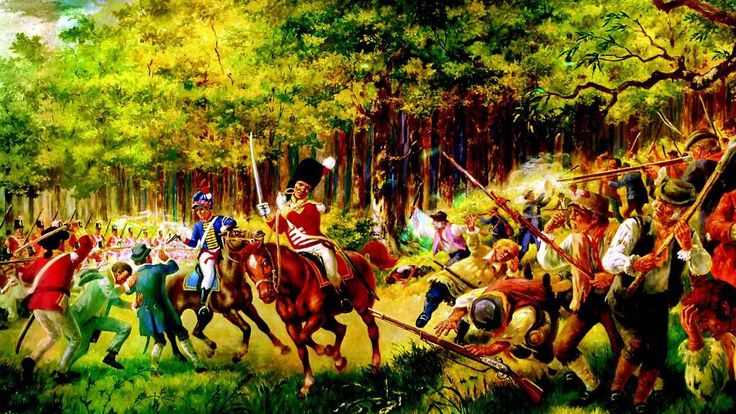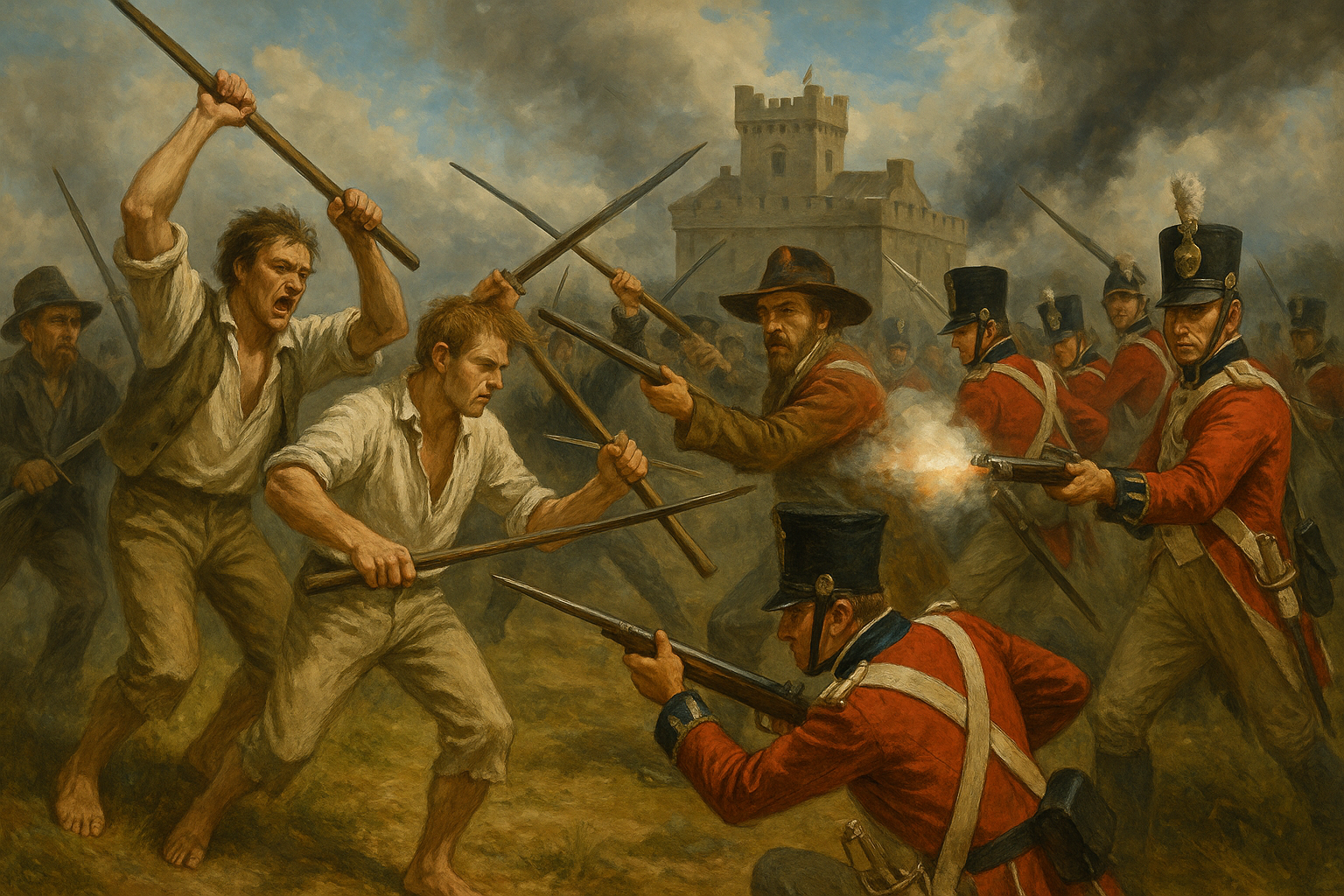
In the brutal dawn of Australia’s colonial nightmare, where the sun scorched the earth with imperial disdain, a fire was kindled.
This was no mere uprising. It was a poet’s war, a symphony of shattered chains, a hymn of defiance sung with blood and steel.
These men and women, torn from their emerald homeland, carried the embers of the 1798 Rebellion across oceans, their hearts unbowed.
Their cry of “Death or Liberty” was a thunderclap, a vow that shook the foundations of empire.
For more tales of Ireland’s unquenchable spirit, explore Secret Ireland’s rebellion chronicles.
Why Did the Castle Hill Rebellion Happen? The Roots of Rage
Because oppression is a spark, and the Irish were tinder soaked in centuries of blood.
The 1798 Rebellion in Ireland, a savage stand against British tyranny, had been crushed, its leaders slaughtered or exiled.
Yet its fire lived on, carried by men and women shipped to Australia’s penal hell in New South Wales.
The 1798 Irish Rebellion was their crucible, a fight for freedom that left scars too deep to heal.
In Australia, they faced a new torment: starvation, the lash’s cruel kiss, and the contempt of British overlords.
The Castle Hill Rebellion speaks of their fear—a fear not of death, but of the Irish spirit that refused to break.
Whispers of Robert Emmet’s 1803 rebellion in Dublin reached them, a siren call to rise again.
They didn’t just want freedom. They wanted to sail home, to plant a Tree of Liberty on Irish soil, to finish the song of 1798.
This was no petty revolt. It was a sacred oath, a rebellion born in the ashes of hope.
Their chains were not just iron; they were the weight of empire, and the Irish would not carry them quietly.
Who Was Involved in the Castle Hill Rebellion? Warriors of a Lost Cause

At its heart stood Philip Cunningham, a Kerryman carved from Ireland’s ancient stone.
A stonemason by trade, Cunningham was a veteran of 1798, a mutineer on the convict ship Anne, his soul a furnace of defiance.
By his side was William Johnston, another Irish rebel, his heart a mirror of Cunningham’s unyielding fire.
They led 300 convicts, mostly Irish, their blood still warm with the memory of Vinegar Hill’s slaughter.
A handful of English and Scots joined them, bound not by nation but by a shared hatred of their chains.
These were no common criminals. They were poets of rebellion, their weapons—stolen muskets, makeshift pikes—their verses.
Their cry of “Death or Liberty” was a lover’s vow, a promise to the ghosts of Ireland’s fallen.
Against them stood the New South Wales Corps, led by Major George Johnston, and a militia of settlers, armed with empire’s cold steel.
The Castle Hill Rebellion documentary sources paint them as outcasts who dared to dream of a world unchained.
Their story burns with the same ferocity as Thomas Francis Meagher, Ireland’s patriot and America’s Civil War hero.
Women, too, played their part, their names lost but their courage woven into the rebellion’s tapestry.
They were the damned, the exiled, the unbroken, and their stand was a poem written in blood.
What Happened in the Castle Hill Rebellion? A Night of Fire and Fury
On March 4, 1804, the night was split open by a blaze.
John Cavenah, a rebel with a poet’s heart, set his hut alight at Castle Hill Government Farm, a beacon of defiance.
The Castle Hill Rebellion summary tells of 300 convicts overwhelming their guards, seizing muskets, pikes, anything that could kill.
Led by Cunningham, they planned a daring march: first Parramatta, then the Hawkesbury to rally 1,100 more.
Their goal was Sydney’s Port Jackson, where they’d capture ships and sail to Ireland, their hearts alight with dreams of revolution.
They raided farmhouses, gathering weapons, their spirits soaring with the promise of liberty.
Their plan was audacious, a middle finger to the empire that had chained them.
But rebellion is a fickle muse. The Castle Hill Rebellion PDF accounts reveal chaos in the dark, rebels lost in the sprawl of night.
By dawn on March 5, Major Johnston’s forces caught them at Rouse Hill—Australia’s Vinegar Hill, a nod to 1798’s blood-soaked stand.
Under a flag of truce, Cunningham was betrayed, arrested, his dream snuffed out by British deceit.
The rebels, outgunned and outnumbered, were scattered in a storm of bullets, their hymn silenced but not forgotten.
Yet, in that fleeting night, they wrote a chapter of defiance that history could not erase.
What Was the Outcome of the Castle Hill Rebellion? A Flame That Endures
The British crushed the uprising with a butcher’s precision.
Governor Philip Gidley King declared martial law, his pen signing death warrants with cold ink.
Cunningham and eight others were hanged, their bodies left swinging as grim warnings to the living.
Thirty-nine convicts died—some in battle, others in the brutal reprisals that followed.
Seven faced the lash’s cruel bite; others were banished to the Coal River chain gang, a living death.
Yet, the Castle Hill Rebellion Wikipedia proclaims it no failure. Its fire lit the path to the Eureka Stockade of 1854.
Miners, shouting “Vinegar Hill,” carried the rebels’ torch, their fight for justice an echo of 1804.
Like Ned Kelly, Australia’s outlaw legend, the Castle Hill rebels became myths, their defiance immortal.
Their defeat was not the end but a beginning, a spark that would ignite future rebellions.
Their blood stained Australia’s soil, but their dream of liberty burned brighter than ever.
Castle Hill’s Legacy: A Shrine to the Unbroken
It’s a monument to the human spirit, where exiles dared to defy an empire.
Castle Hill Heritage Park, 20 hectares of sacred earth, whispers their story to those who listen.
A sculpture near Castlebrook Cemetery stands as their epitaph, a silent tribute to their courage.
The 2004 bicentenary re-enactment, captured by the ABC, brought their fire to life, a reminder that history’s heart still beats.
The Castle Hill Rebellion documentary sources tell of a legacy that transcends defeat, a flame that inspired Australia’s fight for fairness.
The 1798 Rebellion, though broken, was the mother of this uprising, its failure birthing a nationalism that shaped Ireland’s future.
Explore its roots at Secret Ireland’s rebellion archives, where the past roars with defiance.
The 19 crimes to be sent to Australia—theft, forgery, treason—were the empire’s excuse to banish dreamers.
Stealing a loaf or plotting rebellion, it mattered not; the punishment was exile to a land of chains.
Yet, in banishing the Irish, Britain sowed the seeds of resistance, planting fire in Australia’s red dust.
Castle Hill is more than a place. It’s a battle cry, a poem, a vow that the fight for freedom never dies.
Its rebels, like the ghosts of 1798, haunt the present, their courage a beacon for all who dare to dream.
Their story is not just history; it’s a challenge, a call to stand against oppression, to sing liberty’s song.
From the ashes of their defeat rose a legacy that would inspire the Eureka Stockade, a rebellion that echoed their cry.
Castle Hill is a testament to the unbreakable, a place where the human spirit refused to bow.
The Irish Heart in Australia’s Soil
The Castle Hill Rebellion was Ireland’s heart transplanted to Australia, beating in defiance of empire.
These convicts were not just prisoners; they were the sons and daughters of a nation that refused to die.
Their rebellion was a love letter to Ireland, written in the blood of those who dared to dream.
The British thought they could extinguish that fire with chains and gallows, but they were wrong.
The Castle Hill Rebellion PDF accounts tell of a spirit that could not be caged, a flame that burned beyond death.
The rebels’ cry of “Death or Liberty” was not just a slogan; it was a sacred vow, a promise to their ancestors.
They fought not just for themselves but for every soul crushed by empire’s boot.
Their defeat was a tragedy, but their courage was a triumph, a light that pierced the darkness.
Like Ireland’s darkest legends, their story is one of raw, unyielding humanity.
Castle Hill stands as their monument, a place where history sings of freedom’s eternal fight.
Their legacy lives in every act of defiance, every heart that refuses to kneel.
The rebellion was a moment, but its echo is eternal, a song that will never fade.
Frequently Asked Questions About the Castle Hill Rebellion
What Happened in the Castle Hill Rebellion? A Night of Defiant Fire
What happened in the Castle Hill Rebellion?
In the black heart of March 4, 1804, Australia’s soil trembled with Irish fury.
A blaze at Castle Hill Government Farm signaled revolt, a fist raised against empire’s chains.
Three hundred convicts, led by Philip Cunningham, seized weapons, their eyes fixed on freedom.
They dreamed of storming Sydney, capturing ships, sailing home to reignite Ireland’s fight.
But dawn brought betrayal at Rouse Hill, where British steel silenced their song.
Discover more rebel legends at Secret Ireland’s rebellion stories.
At least 39 rebels fell—15 cut down at Rouse Hill, their blood soaking the earth.
Nine more, including Cunningham, were hanged, their deaths a spectacle of British vengeance.
Some vanished into the bush, their fates unwritten, their courage undimmed.
The Castle Hill Rebellion PDF hints at a higher toll, lost to history’s shadows.
Why Was the 1798 Rebellion Significant Despite Its Failure?
Why was the 1798 rebellion significant even though it failed?
The 1798 Rebellion was Ireland’s soul laid bare, a bloody vow against tyranny.
It united Catholic and Protestant, a dream of equality born in revolution’s fire.
Though crushed, with 30,000 dead, it sowed the seeds of Irish nationalism.
Its exiles carried that fire to Australia, igniting Castle Hill’s defiant blaze.
The Castle Hill Rebellion Wikipedia ties 1798 to 1804, a chain of unyielding hope.
Explore this legacy at Secret Ireland’s rebellion archives.
What Is Castle Hill Famous For? A Rebel’s Eternal Stand
What is Castle Hill famous for?
Castle Hill is a shrine to defiance, where Irish convicts wrote their legend in blood.
The 1804 rebellion, Australia’s first, burns as its heart, a second Vinegar Hill.
Castle Hill Heritage Park preserves their story, a sculpture their silent tribute.
The 2004 re-enactment, filmed by the ABC, revived their fire for a new age.
It echoes the spirit of Ned Kelly’s outlaw legend.
What Were the 19 Crimes That Led to Australia’s Exile?
What were the 19 crimes to be sent to Australia?
Empire’s justice was a blade, exiling men for sins both small and grand.
The 19 crimes spanned theft, forgery, arson, robbery, and treason.
Stealing a loaf or plotting rebellion—it mattered not; the sentence was exile.
For the Irish, their crime was defiance, a refusal to bow to British rule.
These laws forged Australia’s rebellious heart, a nation born of outcasts.
Which Country Fueled the Castle Hill Rebellion’s Fire?
Which country did most of the Castle Hill Rebels come from?
Ireland was the rebellion’s soul, its convicts the fire in its veins.
Most of the 300 rebels were Irish, scarred by 1798’s bloody defeat.
Exiled on ships like Anne, they carried their homeland’s fight to Australia.
Their cry of “Death or Liberty” was Ireland’s song, sung in a foreign land.
Meet another Irish hero at Thomas Francis Meagher’s story.
When Did the Castle Hill Rebellion Begin and End?
When did the Castle Hill Rebellion start and end?
The rebellion blazed to life on March 4, 1804, with a fire at Castle Hill’s farm.
By March 5, it was extinguished, crushed at Rouse Hill in a hail of bullets.
Martial law lingered until March 10, as Britain hunted the last embers of defiance.
The Castle Hill Rebellion documentary captures this fleeting, furious stand.
One night of glory, its echo reverberates through history’s heart.



